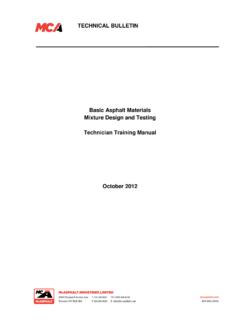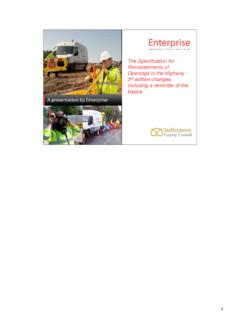Transcription of ASHALT PAVEMENTS and the ENVIRONMENT
1 ASHALT PAVEMENTS . and the ENVIRONMENT . By Dr. Gerhard Kennepohl, University of Waterloo Ontario, Canada Acknowledgement: Keynote Lecture presented to the ISAP. The author thanks Dr. Ralph Haas, the International Symposium held in Z rich, Norman W. McLeod Engineering Professor, August 2008. and the team at the Centre for pavement &. Transportation Technology at University of Waterloo for their continuing support. ABSTRACT: This keynote lecture provides an introduction and overview of the challenges and opportunities that face the paving asphalt industry in view of major changes in technology, economy and the ENVIRONMENT . The scope and issues for dealing with these challenges are rather wide and complex because the goals, perspectives and expectation for environmental practice and control have changed dramatically over the last couple of decades. Hence the required approach has to be multidisciplinary, based on established scientific concepts and sound engineering principles as well as closely focused.
2 This presentation provides historical background and facts for dealing successfully with environmental asphalt issues in the past. In addition to environmental protection, the broader scope concerning the ENVIRONMENT includes the increasing awareness and concepts for ecology and sustainability. The achievements and the status of current technology are presented for: 1. Environmental protection, 2. Ecology, 3. Sustainability development, 4. Standards, Policies and Environmental Law. For future direction and opportunities, suggestions are made for new materials and processes based on existing innovative technology such as warm asphalts' for reducing energy consumption and emissions or improvement of recycling of asphalt PAVEMENTS to limit the continuing increase in resource consumption with the goal to achieve sustainability. ISAP 2008 Kennepohl: asphalt & ENVIRONMENT Page 1 of 15. Introduction The first International Symposium on asphalt PAVEMENTS and the ENVIRONMENT carries with it, a message of much greater importance than drinking together at a social gathering to exchange opinions, as the original meaning of the name symposium' may suggest.
3 The mandate of the speakers as well as all participants is to address, discuss and initiate ideas and projects to deal proactively with environmental challenges and also seize opportunities for innovative solutions. Since the International Society of asphalt PAVEMENTS (ISAP) held a successful workshop on asphalt fumes in Baltimore, Maryland, USA (November 1989) and many environmental, technical and economical changes have taken place since, this symposium is timely indeed, if not already overdue. You are invited to travel the continuing road of asphalt pavement development from its origin over a century ago to the present and beyond to the future. The scenery varies from a quiet rural road ( ) to a busy, high density highway network ( ). Figure 1: Scenic Rural Road Figure 2: Busy Highway Network The purpose of this journey through time is not only to admire, observe and analyze the progress and success of our industry with respect to scale of economy, but also to determine the impact, interaction and synergism with emphasis on our hostal' surrounding or better known by its technical term, the ENVIRONMENT .
4 We simply ask the questions: What are the issues and challenges? Why must we address environmental issues? How do we approach and deal with the challenges? When do we start? The key objectives for this opening lecture are: 1. to provide an introduction and overview of the main theme, 2. to inspire and convince the audience by raising critical issues and questions, 3. to summarize achievements and deliver a focused status report, and 4. to outline technological trends and suggest guidelines for future research world-wide. The goals, perspectives and expectations for environmental practice and control changed dramatically, especially over the last couple of decades. Pollution control in terms of emission and leaching is no longer good enough. While new features, concepts, standards and regulations are being added; planning for a clean, safe, sustainable ENVIRONMENT seems more like aiming at a moving target. Considering also, that a multidisciplinary approach such as science, engineering, toxicology, medicine, etc.
5 Is required, this undertaking is a quite formidable and challenging task, at least when it is condensed to a 40-minute presentation. ISAP 2008 Kennepohl: asphalt & ENVIRONMENT Page 2 of 15. Therefore, we need to closely define and limit the scope and technical terms as well as to focus and concentrate on the most important aspects of asphalt PAVEMENTS and their impact on the ENVIRONMENT . In order to identify meaningful goals and priorities the chosen approach will be based on established science concepts and sound engineering principles. Also, there will be no time for engaging in speculations, political exploitation, equally diverse and often controversial proposals to foster environmental protection, including regulations, financial incentives, investments, etc. The main content of this presentation is covered in the following sections (a) Back to Basics', an account of historical background and facts for dealing with the wider scope of the ENVIRONMENT and the development of basic concepts and methodology for addressing new challenges, (b) Achievement and Status' of the required technology, (c) 'Future Direction and Opportunities', and (d) Summary and Recommendations'.
6 Back to Basics Historical Background and Facts about asphalt The terms asphalt ' and bitumen' are used here interchangeably as they have their roots both in antiquity, asfaltos' (Greek>sticky) and bitumen' (Latin>pitchy). Most paving asphalts are straight-run products made from crude oil by topping the light ends. This means all lighter and medium heavy hydrocarbons have been removed by straight distillation, steam distillation or most frequently vacuum distillation. The remaining black, heavy viscous, sticky, thermoplastic residue is the soft asphalt we are commonly using as paving mix binder. Any modification, by extensive heat-soaking, oxidation, blending with other hydrocarbons or active additives may change the composition and properties, which also may include environmental emissions and leaching. Hence, we usually identify modified paving asphalts accordingly. For environmental studies, we must recognize the importance of the asphalt 's pyrogenous origin' and composition as well as any subsequent cracking or modification (1).
7 A typical example is the early practice of using asphalt admixtures with coal tar (2), which is known to contain carcinogenic benzopyrene amongst other polyaromatic hydrocarbons (PAH). Since asphalts are derived from heavy crude oil deposits they can be considered as a valuable resource provided by nature and its long range capabilities to recycle. Such deposits were formed underground from plant and animal remains that have been subjected to millions of years of heat and pressure. The Athabasca Tar Sands in Western Canada are estimated to be the world's largest deposit with an area of 78,000, square kilometers and an estimated quantity of 2700 billion barrels (3). Legend has it that the reed basket in which Moses was set adrift as a baby was coated with asphalt . At that time the Egyptians knew all about the adhesive and water proofing properties of naturally occurring asphalt deposits in the region. In fact, the Babylonians in the valley of the Euphrates River in Iraq were using asphalt as far back as 6000 BC, making it arguably' man's oldest engineering material (2, 4).
8 Today's asphalt recovery by vacuum or steam distillation as described in the definition of asphalt above, produces a material with very low vapour pressure. Therefore, the quantities of emission for hydrocarbons are small for the temperature range relevant for paving applications and a typical Occupational Emission Monitoring (OEL) level is 5 mg/m (5). Asphalts have extensively been used as a sealant in water tanks including aquariums and found to be inert and insoluble in water. Aqueous leaching of poly-aromatic hydrocarbons (PAH) has been shown by Kriech (6) to be below detection limits with a few exceptions. A. National Cooperative Highway Research Program (7) carried out at Oregon State University describes the results of laboratory testing a first level screening tool. The asphalt PAVEMENTS were found to pose no harm to the ENVIRONMENT . Since the introduction of the automobile and the demand for clean and safe transportation grew rapidly, the now existing asphalt pavement network around the globe has contributed tremendously to the development and economic success of many countries.
9 At the same time governments and the industry have also recognized the increasing demand and costs on resources, which resulted in the fact that asphalt roads make up the largest amount of recycled materials worldwide. Actually, in some regions a zero-waste policy already exists. The great success of asphalt PAVEMENTS is largely based on the following key features of its origin and industrial development: ISAP 2008 Kennepohl: asphalt & ENVIRONMENT Page 3 of 15. Utilization of large deposits of naturally recycled organic materials Experience with the oldest engineering material Over 4000 years track record of environmental safe applications Performance targeted selection and production of paving asphalts Proven recycling technology and the world's largest material recycling operation Proven to be and still is the most cost-effective paving material in existence. The many faces of ENVIRONMENT The importance of environmental protection, a main thrust of pollution, has in the past fluctuated, but more recently changed to become indisputably a subject of serious and persistent concerns as well as to assume a much wider scope.
10 Focusing on the wider scope', we notice a succinct metamorphosis in the concept of ENVIRONMENT . Signs of environmental deterioration, such as air and water pollution, extinction of species, and the depletions of resources as well as their causes, including impact of technology and population expansion are increasing. So are also and just as diverse, the proposed answers to these problems, public education, financial incentives, regulations, etc. Even the terminology has been changing and expanding dramatically since Rachel Carson published her classical environmental book Silent Spring (8). At that time, prompted by increasing awareness and concerns, new concepts and descriptions were needed. Added to the traditional terms ENVIRONMENT (our surrounding) were ecology (our home) and then sustainability (our survival). These new terms should not be misused or misrepresented as, for example, in the vacation advertisement depicted in Figure 3.







